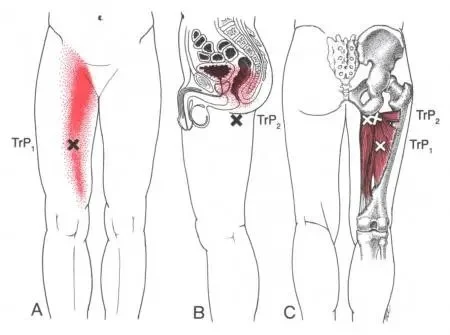Pelvic Floor Symptoms: How Dry Needling Can Help
Dry needling is a specialized technique used by physical therapists to help treat a wide variety of musculoskeletal and neuromuscular conditions and injuries and is commonly used to relieve pain, improve range of motion, reduce muscle tension, and facilitate healing.
But can dry needling help with pelvic floor symptoms?
It depends on what is causing the symptoms. Common pelvic floor symptoms are leaking, pain, and heaviness in the pelivc region. Pelvic floor related conditions are typically multifactorial - there are usually a lot of factors that can contribute to what you are experiencing. In a recent review of the research, pelvic floor dysfunction has been shown to correlate with [1]:
Abnormal movement patterns
Altered breathing patterns
Altered posture (eg resting in excessive anterior or posterior pelvic tilt)
Core muscle weakness
Decreased hip mobility (or hip stiffness)
Temporomandibular joint (TMJ) disorders
Muscle and myofascial tension
Restricted tissue mobility due to scars
Poor pressure management
Research has also found that “Women with LBP [low back pain] are more likely to experience UI [urinary incontinence], and have weak PFM [pelvic floor muscles] regardless of the occurrence of UI.” [1]
How Dry Needling Can Help
In the right circumstances, dry needling in the hips and low back around the pelvic floor can help to take stress off of the pelvic floor.
Dry needling:
Relieves pain
Improves range of motion
Reduces muscle tension
Facilitates healing
During an evaluation, we look for both the big picture of what is going on and the details that are likely contributing to the issue.
Client example:
A client comes to physical therapy with pelvic floor symptoms. During the evaluation we find very tight muscles around the hips causing limited hip mobility. Dry needling to the affected hip muscles will help reduce muscle tension, improve hip range of motion. This will result in taking stress off of the pelvic floor, and then reducing pelvic floor symptoms (pain, heaviness, leaking, etc).
Other real client scenarios:
A client comes in with symptoms and altered posture. Dry needling the tight muscles contributing to that posture will help reduce the demand placed on the pelvic floor.
A client who has restricted tissue mobility due to scaring. Dry needling can help decrease the scar restrictions.
A client reports incontinence (bladder leaking) and a history of low back pain. Using dry needling to release tension in the low back musculature can help with healing.
The list goes on!
Trigger points and referred pain
There are also places in the body that can mimic pelvic floor pain, but the pelvic floor itself is not the main culprit. This is called referred pain.
In the pictures below [2], the white and black “X” marks are showing where tension and trigger points are found in different muscles and the red shading indicates common referral patterns.
If you notice the adductor muscles below, a trigger point in the inner thigh can actually feel pain inside the pelvic cavity instead! We will use dry needling to target those muscles that may be mimicking pelvic pain.
This has been a technique that has made dramatic results for a lot of our patients at Anchor Physical Therapy & Performance, and we want everyone to know about it!
However, it is important to note that dry needling alone is not usually a long term solution. Dry needling can help to decrease tension, but it will not solve why the tension developed in the first place. Dry needling is a phenomenal tool we can use to help kick-start and support the process, but we will also work to help you find exercises and stretches that will help to support the body and reverse the cycle of pain and tension.
If you have further questions about dry needling, book a free discovery call with us! We are happy to answer any questions or concerns you may have. You can also learn more about the specifics of dry needling and how it works in our blog here.
Resources
Tim, Sabina, and Agnieszka I. Mazur-Bialy. The Most Common Functional Disorders and Factors Affecting Female Pelvic Floor. vol. 11, Krakow, Poland, Life, 2021. MDPI Open Access Journals, https://www.mdpi.com/2075-1729/11/12/1397. Accessed 13/1/2025.
Donnelly, Joseph M. Travell, Simons & Simons Myofascial Pain and Dysfunction: the Trigger Point Manual. 3rd ed., Wolters Kluwer Health, 2019.


